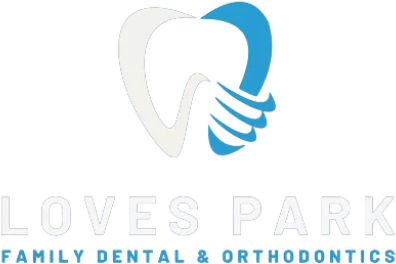At Loves Park Family Dental and Orthodontics we strive to have each childs’ visit address his/her’s special dental needs and to create a positive experience.
We make every effort to motivate and guide each child towards a healthy smile through education that is fun and entertaining.

Kids Dentistry
Baby Talk (Birth to 29 months)
The primary teeth begin their development when the fetus is five weeks old, but do not appear in the mouth until the lower central incisors erupt at approximately six months of age. The normal ages of eruption vary greatly from child to child, although the sequence in which the teeth appear does not change. The primary teeth are of major importance to your child’s appearance, their chewing ability, and eventual health of his or her permanent teeth.
Permanent Teeth (6 years old to 21 years old)
Ideally, although not always, the first permanent molars are the first of the teeth to appear. Often mistaken by parents for primary teeth, these teeth, frequently called the “six-year molars,” may emerge as early as five and a half years of age or as late as nine and a half years old. They appear behind the second primary molars; they do not replace them. At about the same time that the molars are appearing, the lower primary incisors are loosening in preparation to be lost and replaced by the lower permanent incisors. Pay special attention to maintaining the health of the four first permanent molars, which because of their large size and location in the mouth are of major importance to your child’s chewing ability and critical to the development of the face and jaws. Click Here to view the progression of permanent teeth.
Baby Bottle Tooth Decay
Counseling includes:
- Eliminate sugared liquid during sleeptime
- Encourage daily tooth cleaning
- Discourage at-will feedings
- Discourage use of sweeteners on pacifiers
Thumb and Pacifier Habits
- Use only sturdy, one-piece, non-toxic, flexible pacifier
- Never attach around child’s neck
- Discourage use of sweeteners
- Replace the pacifier when worn
Good Diet = Healthy Teeth
- Psyche
- Primary teeth
- Permanent teeth
- Growth of upper and lower jaws
- Speech
Tooth decay is a chronic disease that is the most common among children – five times more common than asthma. From infancy through the teenage years, children’s dentistry focuses not only on proper oral hygiene habits, but on dental issues specific to children. We recommend that your child visits the dentist by age 3- unless you have any questions or concerns before then.
Your Child’s First Visit
We welcome the parent(s) presence during examination and treatment visits. However, this privilege will be evaluated according to each child’s behavior. The parent(s) should be a passive observer at all times during the child’s dental visit. We want your child’s visit to our office to be a happy one. If your child has questions that are difficult for you to answer, please refer him/her to Dr. Patel for the proper answer and discussion.
Your child’s first dental visit in our office will include:
– Meeting Dr. Patel and his staff and becoming oriented with the dental office.
– A thorough oral examination.
– Cleaning of teeth, flossing, scaling (as needed) and office fluoride treatment.
– Obtaining x-ray films for diagnostic purposes (only as needed). We follow the guidelines from the American Academy of Pediatric Dentistry and American Dental Association.
Consulting on the following:
– Diet
– Home oral hygiene which consists of tooth brushing, tooth paste, flossing and fluoride treatment
– Oral habits
– Tooth brushing technique for your child
– Occlusion (bite)
– Behavior management for home oral hygiene
Sealants
A sealant helps protect the your child’s teeth from cavities. A sealant is a thin, plastic coating applied to the chewing surface of molars, premolars and any deep grooves (called pits and fissures) of teeth. More than 75% of dental decay begins in these deep grooves. Teeth with these conditions are hard to clean and are very susceptible to decay. A sealant protects the tooth by sealing deep grooves, creating a smooth, easy to clean surface. Sealants can protect teeth from decay for many years, but need to be checked for wear and chipping at regular dental visits.
Reasons for sealants:
Children and teenagers – As soon as the six-year molars (the first permanent back teeth) appear or any time throughout the cavity prone years of 6-16.
Adults – Tooth surfaces without decay that have deep grooves or depressions.
Baby teeth – Occasionally done if teeth have deep grooves or depressions and child is cavity prone.
What do sealants involve?
Sealants are easily applied by your dentist or dental hygienist and the process takes only a couple of minutes per tooth.
The teeth to be sealed are thoroughly cleaned and then surrounded with cotton to keep the area dry. A special solution is applied to the enamel surface to help the sealant bond to the teeth. The teeth are then rinsed and dried. Sealant material is carefully painted onto the enamel surface to cover the deep grooves or depressions.
Proper home care, a balanced diet, and regular dental visits will aid in the life of your new sealants.
Fluoride Treatment
Fluoride is the most effective agent available to help prevent tooth decay. It is a mineral that is naturally present in varying amounts in almost all foods and water supplies. The benefits of fluoride have been well known for over 50 years and are supported by many health and professional organizations.
Fluoride works in two ways:
Topical fluoride strengthens the teeth once they have erupted by seeping into the outer surface of the tooth enamel, making the teeth more resistant to decay. We gain topical fluoride by using fluoride containing dental products such as toothpaste, mouth rinses, and gels. Dentists and dental hygienists generally recommend that children have a professional application of fluoride twice a year during dental check-ups.
Systemic fluoride strengthens the teeth that have erupted as well as those that are developing under the gums. We gain systemic fluoride from most foods and our community water supplies. It is also available as a supplement in drop or gel form and can be prescribed by your dentist or physician. Generally, fluoride drops are recommended for infants, and tablets are best suited for children up through the teen years. It is very important to monitor the amounts of fluoride a child ingests. If too much fluoride is consumed while the teeth are developing, a condition called fluorosis (white spots on the teeth) may result.
Although most people receive fluoride from food and water, sometimes it is not enough to help prevent decay. Your dentist or dental hygienist may recommend the use of home and/or professional fluoride treatments for the following reasons:
- Deep pits and fissures on the chewing surfaces of teeth.
- Exposed and sensitive root surfaces.
- Fair to poor oral hygiene habits.
- Frequent sugar and carbohydrate intake.
- Inadequate exposure to fluorides.
- Inadequate saliva flow due to medical conditions, medical treatments or medications.
- Recent history of dental decay.
Your Child's Home Care
A beautiful, healthy smile that lasts a lifetime is our ultimate goal when treating our young patients. Your child’s personal home care plays an important role in achieving that goal. Your child’s personal home care starts by eating balanced meals, reducing the number of snacks you eat, and correctly using the various dental aids that help control the plaque and bacteria that cause dental disease.
Good Diet = Healthy Teeth
Your children will learn excellent oral hygiene habits that will last them a lifetime:
– Brushing
– Flossing
– Feeling comfortable in a dentist’s office
– Avoiding tooth decay
– Facts and information in a way that is understandable for children
Tooth Brushing
- Place the brush at a 45 degree angle to the gums and gently brush using a small, circular motion, ensuring that you always feel the bristles on the gums.
- Brush the outer, inner, and biting surfaces of each tooth.
- Use the tip of the brush to clean the inside of the front teeth.
- Brush your tongue to remove bacteria and freshen your breath.
- Electric toothbrushes are also recommended. They are easy to use and can remove plaque efficiently. Simply place the bristles of the electric brush on your gums and teeth and allow the brush to do its job, several teeth at a time.
Flossing
- Take 12-16 inches (30-40cm) of dental floss and wrap it around your middle fingers, leaving about 2 inches (5cm) of floss between the hands.
- Using your thumbs and forefingers to guide the floss, gently insert the floss between teeth using a sawing motion.
- Curve the floss into a “C” shape around each tooth and under the gum line. Gently move the floss up and down, cleaning the side of each tooth.
- Floss holders are recommended if you have difficulty using conventional floss.
Rinsing
It is important to rinse your mouth with water after brushing, and also after meals if you are unable to brush. If you are using an over-the-counter product for rinsing, it’s a good idea to consult with your dentist or dental hygienist on its appropriateness for you.
Use other dental aids as recommended by your dentist or dental hygienist: Interdental brushes, rubber tip stimulators, tongue cleaners, irrigation devices, fluoride, medicated rinses, etc., can all play a role in good dental home care.
Mouth Guards
When you participate in recreational activities and organized sports, injuries can occur. A properly fitted mouth guard, or mouth protector, is an important piece of athletic gear that can help protect your smile, and should be used during any activity that could result in a blow to your face or mouth. Mouth guards help prevent broken teeth, and injuries to the lips, tongue, face or jaw. Dr. Patel’s entire dental team will provide exceptional care for your children. We create a fun, warm and relaxed atmosphere for your family. You will be impressed with our personal, individualized approach to treating your children. How well you take care of your teeth as a child has a lot to do with how long you keep your teeth as an adult.
Your children will learn excellent oral hygiene habits that will last them a lifetime:
– Brushing
– Flossing
– Feeling comfortable in a dentist’s office
– Avoiding tooth decay
– Facts and information in a way that is understandable for children
